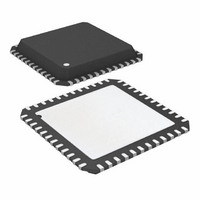ADN2819ACP-CML Analog Devices Inc, ADN2819ACP-CML Datasheet - Page 9

ADN2819ACP-CML
Manufacturer Part Number
ADN2819ACP-CML
Description
IC RECOVER CLOCK/DATA 48-LFCSP
Manufacturer
Analog Devices Inc
Type
Clock and Data Recovery (CDR)r
Datasheet
1.ADN2819ACP-CML.pdf
(24 pages)
Specifications of ADN2819ACP-CML
Rohs Status
RoHS non-compliant
Output
CML
Frequency - Max
2.7GHz
Voltage - Supply
3 V ~ 3.6 V
Operating Temperature
-40°C ~ 85°C
Mounting Type
Surface Mount
Package / Case
48-LFCSP
Frequency-max
2.7GHz
Input
-
DEFINITION OF TERMS
MAXIMUM, MINIMUM, AND TYPICAL
SPECIFICATIONS
Specifications for every parameter are derived from statistical
analyses of data taken on multiple devices from multiple wafer
lots. Typical specifications are the mean of the distribution of
the data for that parameter. If a parameter has a maximum (or a
minimum), that value is calculated by adding to (or subtracting
from) the mean six times the standard deviation of the
distribution. This procedure is intended to tolerate production
variations. If the mean shifts by 1.5 standard deviations, the
remaining 4.5 standard deviations still provide a failure rate of
only 3.4 parts per million. For all tested parameters, the test
limits are guardbanded to account for tester variation and
therefore guarantee that no device is shipped outside of data
sheet specifications.
INPUT SENSITIVITY AND INPUT OVERDRIVE
Sensitivity and overdrive specifications for the quantizer involve
offset voltage, gain, and noise. The relationship between the
logic output of the quantizer and the analog voltage input is
shown in Figure 8. For a sufficiently large positive input voltage,
the output is always Logic 1; similarly for negative inputs, the
output is always Logic 0. However, the transitions between
output Logic Levels 1 and 0 are not at precisely defined input
voltage levels, but occur over a range of input voltages. Within
this zone of confusion, the output may be either 1 or 0, or it may
even fail to attain a valid logic state. The width of this zone is
determined by the input voltage noise of the quantizer. The
center of the zone of confusion is the quantizer input offset
voltage. Input overdrive is the magnitude of signal required to
guarantee the correct logic level with 1 × 10
Figure 8. Input Sensitivity and Input Overdrive
OUTPUT
(2× OVERDRIVE)
SENSITIVITY
1
0
OFFSET
OVERDRIVE
NOISE
–10
INPUT (V p-p)
confidence level.
Rev. B | Page 9 of 24
SINGLE-ENDED VS. DIFFERENTIAL
AC-coupling is typically used to drive the inputs to the
quantizer. The inputs are internally dc biased to a common-
mode potential of ~0.6 V. Driving the ADN2819 single-ended
and observing the quantizer input with an oscilloscope probe at
the point indicated in Figure 9 shows a binary signal with an
average value equal to the common-mode potential and
instantaneous values above and below the average value. It is
convenient to measure the peak-to-peak amplitude of this
signal and to call the minimum required value the quantizer
sensitivity. Referring to Figure 8, since both positive and
negative offsets need to be accommodated, the sensitivity is
twice the overdrive.
Driving the ADN2819 differentially (see Figure 10), sensitivity
seems to improve by observing the quantizer input with an
oscilloscope probe. This is an illusion caused by the use of a
single-ended probe. A 5 mV p-p signal appears to drive the
ADN2819 quantizer. However, the single-ended probe measures
only half the signal. The true quantizer input signal is twice this
value since the other quantizer input is complementary to the
signal being observed.
SCOPE
PROBE
Figure 9. Single-Ended Sensitivity Measurement
SCOPE
PROBE
Figure 10. Differential Sensitivity Measurement
VREF
VREF
PIN
NIN
10mV p-p
PIN
5mV p-p
ADN2819
ADN2819
50Ω
50Ω
50Ω
50Ω
+
QUANTIZER
+
QUANTIZER
VREF
VREF
ADN2819












